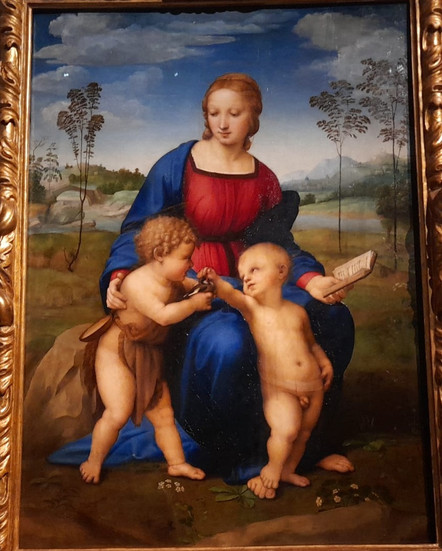Where to see Raphael's masterpieces in Florence and Rome
- Deborah Cater
- Apr 7
- 3 min read
If you’ve ever admired the elegance of Raphael’s paintings in a book or on a TV programme, nothing compares to seeing them in person. Discover Raphael's masterpieces in Florence and Rome.
His brushwork, balance, and human warmth truly come alive when viewed up close. From his early Florentine Madonnas to the grandeur of his Vatican frescoes, here’s where to follow in Raphael’s footsteps.
Raphael in Florence: The Formative Years
Before the glory of Rome, there was Florence. Raphael arrived here around 1504, absorbing the works of Leonardo and Michelangelo and refining his own style in their wake. While much of his output from this period has since travelled abroad, there are still som of Raphael's masterpieces in Florence, for those who know where to look.
Uffizi Gallery
Florence’s famed Uffizi Gallery holds several works by Raphael, including:
The Madonna of the Goldfinch (1506)
This serene masterpiece shows the Virgin Mary with the infant Christ and St. John the Baptist. The triangular composition and gentle expressions are typical of Raphael’s early genius—and were restored after a devastating 16th-century collapse that split the painting in two.
Portraits of Agnolo Doni and Maddalena Strozzi
This influential Florentine couple were key patrons—Agnolo also commissioned Michelangelo’s Tondo Doni. Raphael’s portraits are elegant and detailed, blending the sitter’s social standing with a quiet dignity.
One of the Uffizi’s great strengths is the chance to compare Raphael’s works directly with those of Leonardo and Michelangelo, three geniuses in the same space, offering an unparalleled lesson in Renaissance style.
Palatine Gallery, Pitti Palace
Madonna della Seggiola (c. 1513–1514)
Widely regarded as one of Raphael’s most beautiful and emotionally powerful Madonnas. The circular composition and warm colour palette make this painting deeply moving.
La Velata (c. 1512–1515)
According to Giorgio Vasari (1550, 1568), who observed the painting in the house of the merchant Matteo Botti in Florence, the work features Margherita Luti, known as La Fornarina, a woman who Raphael loved throughout his life.
Raphael in Rome: A Master at the Peak of His Powers
It was in Rome that Raphael reached full maturity. From 1508 until his untimely death in 1520, he produced some of the most celebrated works of the Renaissance.
The Vatican Museums
The Raphael Rooms (Stanze di Raffaello)
Commissioned by Pope Julius II, these four rooms within the Vatican Palace contain monumental frescoes that reflect Raphael’s brilliance in philosophy, theology, law, and poetry.
The School of Athens is the most famous—a vast, harmonious composition of ancient philosophers in an imagined classical hall.
The Disputation of the Holy Sacrament and The Parnassus demonstrate Raphael’s skill in sacred and poetic themes.
The scale, complexity, and conceptual unity of these frescoes are nothing short of breathtaking. Visitors often pause longest in the Stanza della Segnatura, drawn into the world of Plato, Aristotle, and Apollo under the guiding hand of Raphael.
The Deposition (1507)
Painted before Raphael moved to Rome but now housed here, The Deposition shows Christ’s body being taken from the cross. It's rich in emotion and movement, foreshadowing the grand dramas of his Roman years.
The Pantheon
Raphael’s final resting place. It's rare that an artist, not a pope nor an emperor, is buried in such a revered place. His tomb bears the inscription:
“Here lies Raphael, by whom Nature feared to be outdone while he lived, and when he died, feared she would die with him.”
The statue of the Madonna above his tomb, said to be commissioned by Raphael himself, is a quiet tribute to the painter’s devotion to grace and beauty.
Why It Matters
To walk in Raphael’s footsteps is to witness the spirit of the Renaissance itself, where humanism, balance, and beauty met in harmony. Whether in the golden light of the Uffizi or the reverent stillness of the Vatican’s Raphael Rooms, his work continues to move and inspire.
Looking to explore these sites with context, stories, and insight?
Book a tour with FloEasy and discover how Raphael helped paint the Renaissance into life.




















Comments